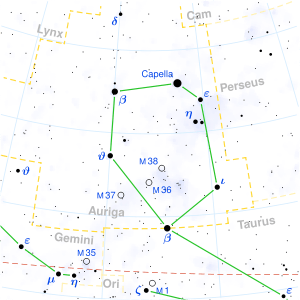Eta Aurigae
Eta Aurigae (η Aurigae, abbreviated Eta Aur, η Aur), officially named Haedus /ˈhiːdəs/,[10][11] is a star in the northern constellation of Auriga. With an apparent visual magnitude of 3.18,[2] it is visible to the naked eye. Based upon parallax measurements made during the Hipparcos mission, this star is approximately 243 light-years (75 parsecs) distant from the Sun.
 | |
| Observation data Epoch J2000 Equinox J2000 | |
|---|---|
| Constellation | Auriga |
| Right ascension | 05h 06m 30.89337s[1] |
| Declination | +41° 14′ 04.1127″[1] |
| Apparent magnitude (V) | 3.18[2] |
| Characteristics | |
| Spectral type | B3 V[3] |
| U−B color index | –0.66[4] |
| B−V color index | –0.18[4] |
| R−I color index | –0.17 |
| Astrometry | |
| Radial velocity (Rv) | +7.3[2] km/s |
| Proper motion (μ) | RA: +31.45[1] mas/yr Dec.: –67.87[1] mas/yr |
| Parallax (π) | 13.40 ± 0.20[1] mas |
| Distance | 243 ± 4 ly (75 ± 1 pc) |
| Absolute magnitude (MV) | −1.18[5] |
| Details | |
| Mass | 5.4 ± 0.3[6] M☉ |
| Radius | 3.25 ± 0.18[7] R☉ |
| Luminosity | 955[6] L☉ |
| Surface gravity (log g) | 4.13 ± 0.04[7] cgs |
| Temperature | 17,201 ± 173[7] K |
| Rotational velocity (v sin i) | 95[8] km/s |
| Age | 22–55[6] Myr |
| Other designations | |
| Database references | |
| SIMBAD | data |
Nomenclature

η Aurigae (Latinised to Eta Aurigae) is the star's Bayer designation.
Along with Zeta Aurigae it represents one of the Kids of the she-goat Capella, from which it derived its Latin traditional name Haedus II or Hoedus II, from the Latin haedus "kid" (Zeta Aurigae was Haedus I). It also had the less common traditional name Mahasim, from the Arabic المِعْصَم al-miʽşam "the wrist" (of the charioteer), which it shared with Theta Aurigae. In 2016, the IAU organized a Working Group on Star Names (WGSN)[12] to catalog and standardize proper names for stars. The WGSN approved the names Haedus for Eta Aurigae and Saclateni for Zeta Aurigae A on 30 June 2017 and they are both now so included in the List of IAU-approved Star Names.[11]
In Chinese, 柱 (Zhù), meaning Pillars, refers to an asterism consisting of Eta Aurigae, Epsilon Aurigae, Zeta Aurigae, Upsilon Aurigae, Nu Aurigae, Tau Aurigae, Chi Aurigae and 26 Aurigae.[13] Consequently, the Chinese name for Eta Aurigae itself is 柱三 (Zhǔ sān, English: the Third Star of Pillars.)[14]
Properties
Since 1943, the spectrum of Eta Aurigae has served as one of the stable anchor points by which other stars are classified.[3]
Eta Aurigae is a larger star than the Sun, with more than five[6] times the Sun's mass and over three times the Sun's radius.[7] The spectrum of this star matches a stellar classification of B3 V,[3] which is a B-type main sequence star that is generating its energy through the nuclear fusion of hydrogen at its core. It is radiating 955[6] times the Sun's luminosity from its outer atmosphere at an effective temperature of 17,201 K.[7] Based upon its projected rotational velocity of 95,[8] it is spinning with a rotation period of only 1.8 days.[15] Eta Aurigae is around 39 million years old.[6]
References
- van Leeuwen, F. (November 2007), "Validation of the new Hipparcos reduction", Astronomy and Astrophysics, 474 (2): 653–664, arXiv:0708.1752, Bibcode:2007A&A...474..653V, doi:10.1051/0004-6361:20078357
- Wielen, R.; et al. (1999), Sixth Catalogue of Fundamental Stars (FK6). Part I. Basic fundamental stars with direct solutions, Astronomisches Rechen-Institut Heidelberg, Bibcode:1999VeARI..35....1W
- Garrison, R. F. (December 1993), "Anchor Points for the MK System of Spectral Classification", Bulletin of the American Astronomical Society, 25: 1319, Bibcode:1993AAS...183.1710G, retrieved 2012-02-04
- Crawford, D. L.; Barnes, J. V.; Golson, J. C. (1971), "Four-color, H-beta, and UBV photometry for bright B-type stars in the northern hemisphere", The Astronomical Journal, 76: 1058, Bibcode:1971AJ.....76.1058C, doi:10.1086/111220
- Anderson, E.; Francis, Ch. (2012), "XHIP: An extended hipparcos compilation", Astronomy Letters, 38 (5): 331, arXiv:1108.4971, Bibcode:2012AstL...38..331A, doi:10.1134/S1063773712050015.
- Lyubimkov, Leonid S.; et al. (June 2002), "Surface abundances of light elements for a large sample of early B-type stars - II. Basic parameters of 107 stars", Monthly Notices of the Royal Astronomical Society, 333 (1): 9–26, Bibcode:2002MNRAS.333....9L, doi:10.1046/j.1365-8711.2002.05341.x
- Fitzpatrick, E. L.; Massa, D. (March 2005), "Determining the Physical Properties of the B Stars. II. Calibration of Synthetic Photometry", The Astronomical Journal, 129 (3): 1642–1662, arXiv:astro-ph/0412542, Bibcode:2005AJ....129.1642F, doi:10.1086/427855
- Abt, Helmut A.; Levato, Hugo; Grosso, Monica (July 2002), "Rotational Velocities of B Stars", The Astrophysical Journal, 573 (1): 359–365, Bibcode:2002ApJ...573..359A, doi:10.1086/340590
- "eta Aur -- Variable Star", SIMBAD, Centre de Données astronomiques de Strasbourg, retrieved 2012-02-08
- Rumrill, H. B. (June 1936). "Star Name Pronunciation". Publications of the Astronomical Society of the Pacific. San Francisco, California. 48 (283). doi:10.1086/124681.
- "Naming Stars". IAU.org. Retrieved 16 December 2017.
- "IAU Working Group on Star Names (WGSN)". Retrieved 22 May 2016.
- (in Chinese) 中國星座神話, written by 陳久金. Published by 台灣書房出版有限公司, 2005, ISBN 978-986-7332-25-7.
- (in Chinese) 香港太空館 - 研究資源 - 亮星中英對照表 Archived January 29, 2011, at the Wayback Machine, Hong Kong Space Museum. Accessed on line November 23, 2010.
- kaler, James B., "HAEDUS II (Eta Aurigae)", Stars, University of Illinois, retrieved 2012-02-09